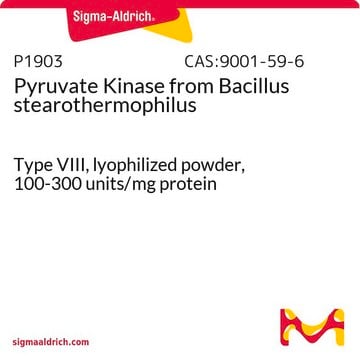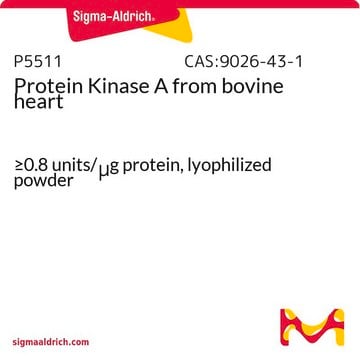Kluczowe dokumenty
P2014
Phosphorylase Kinase from rabbit muscle
lyophilized powder, ≥60 units/mg protein
Synonim(y):
ATP:phosphorylase-b phosphotransferase, Dephosphophosphorylase kinase
About This Item
Polecane produkty
Formularz
lyophilized powder
aktywność właściwa
≥60 units/mg protein
skład
Protein, 20-40% biuret
obecność zanieczyszczeń
ATPase ≤0.5%
phosphorylase a ≤1%
phosphorylase b ≤5%
temp. przechowywania
−20°C
Opis ogólny
Zastosowanie
Definicja jednostki
Postać fizyczna
Kod klasy składowania
11 - Combustible Solids
Klasa zagrożenia wodnego (WGK)
WGK 3
Temperatura zapłonu (°F)
Not applicable
Temperatura zapłonu (°C)
Not applicable
Środki ochrony indywidualnej
Eyeshields, Gloves, type N95 (US)
Wybierz jedną z najnowszych wersji:
Certyfikaty analizy (CoA)
Nie widzisz odpowiedniej wersji?
Jeśli potrzebujesz konkretnej wersji, możesz wyszukać konkretny certyfikat według numeru partii lub serii.
Masz już ten produkt?
Dokumenty związane z niedawno zakupionymi produktami zostały zamieszczone w Bibliotece dokumentów.
Active Filters
Nasz zespół naukowców ma doświadczenie we wszystkich obszarach badań, w tym w naukach przyrodniczych, materiałoznawstwie, syntezie chemicznej, chromatografii, analityce i wielu innych dziedzinach.
Skontaktuj się z zespołem ds. pomocy technicznej







